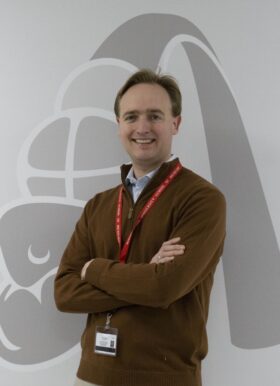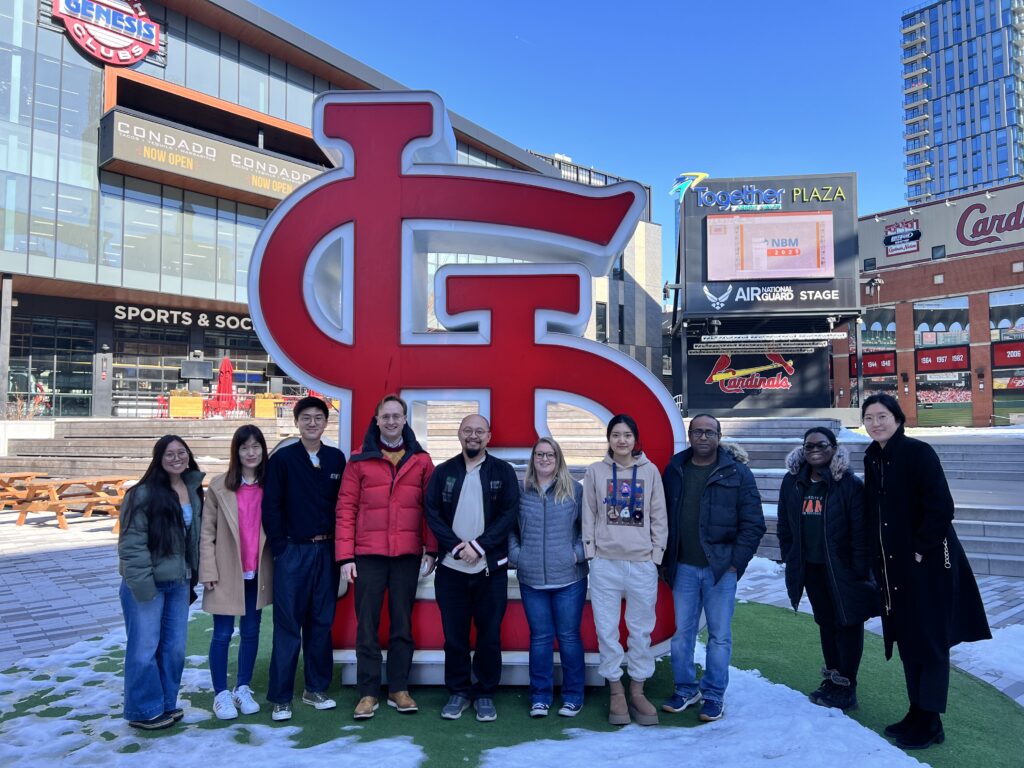
Thorold Theunissen, PhD
Associate Professor of Developmental Biology
- Phone: 314-273-3047
- Email: t.theunissen@nospam.wustl.edu

Research interests
Naïve pluripotency, trophoblast development, and stem-cell-based embryo models
Embryonic stem cells (ESCs) have the ability to self-renew indefinitely while maintaining the capacity to differentiate into all cell types found in the body. Due to these unique properties, ESCs have become a versatile tool in wide-ranging biomedical applications, from disease modeling to toxicology testing to clinical trials. In addition, the discovery of induced pluripotent stem cells (iPSCs) provides new possibilities to model complex genetic disorders and a source of autologous cells for transplantation. However, studies over the past decade have indicated that conventional human ESCs and iPSCs do not resemble the ground state “naive” pluripotent cells found in the blastocyst, but instead are more similar to “primed” precursors that arise after the embryo has implanted. The naive state is signified by an unrestricted developmental potential, whereas the primed state displays repressive chromatin features and lineage priming. We have pioneered approaches to reprogram primed human pluripotent stem cells (hPSCs) into a naïve state that shares defining transcriptional and epigenetic properties with pluripotent cells in human pre-implantation embryos. We also discovered that naïve hPSCs have a remarkable potential for extraembryonic differentiation, which can be leveraged to generate in vitro models of human placental development and stem-cell-based embryo models. Our current research is focused on three key areas:
Understanding different states of pluripotency
We have devised conditions for establishing in culture naïve hPSCs that share critical features with the human pre-implantation embryo. While naïve stem cells can be derived in rodents, their isolation has long remained elusive in humans. By combining genetic and chemical strategies, we derived authentic naïve hPSCs that display a transposon transcription signature, globally hypomethylated DNA methylation landscape, and X chromosome signature that closely recapitulate pluripotent cells in the human pre-implantation embryo. In recent years, we have defined discrete signaling requirements for inducing and maintaining naïve human pluripotency by performing high-throughput chemical screening. In addition, we discovered through biochemical and genetic studies that the core pluripotency transcription factor OCT4 cooperates with distinct ATP-dependent chromatin remodelers in naïve and primed hPSCs. However, current naive hPSCs do not perfectly resemble pluripotent cells in the human blastocyst, as exemplified by their global loss of imprinting and non-random X chromosome inactivation upon differentiation. Thus, an important aim of our research program is to devise improved methods to capture naive hPSCs that are as robust as their mouse counterparts, which may facilitate wide-ranging applications in regenerative medicine.
Building 2D and 3D models of human trophoblast development
Trophoblast constitutes the predominant epithelial cell type in the placenta and originates from the outer layer of cells in the blastocyst, called the trophectoderm. Given the ethical and legal constraints of studying placental development in vivo, there has been significant interest in establishing reliable in vitro model systems of human trophoblast specification and differentiation. We demonstrated that naïve hPSCs have an enhanced potential for differentiation into extraembryonic fates, readily giving rise to self-renewing human trophoblast stem cells (hTSCs). By performing transcriptome profiling, we provided evidence that naïve hPSC-derived hTSCs closely resemble primary hTSCs isolated from the human blastocyst. More recently, we reported the generation of 3D trophoblast organoids from naïve hPSCs and showed by single cell transcriptome profiling that these stem-cell-derived trophoblast organoids (SC-TOs) harbor discrete subpopulations that are closely aligned with trophoblast cell fates in the human post-implantation embryo. We have also shown that SC-TOs are subject to X chromosome inactivation and can be used to model placental susceptibility to emerging viral pathogens. This work establishes a novel cellular model system to elucidate mechanisms of human trophoblast specification. As a starting point for defining candidate genetic regulators, we performed a genome-wide CRISPR/Cas9 screen to identify essential and growth-restricting genes in hTSCs. The candidates identified in this screen provide a framework for elucidating conserved and species-specific regulators of trophoblast development.
Modeling human embryogenesis using naïve hPSCs
The unrestricted developmental potential of naïve hPSCs raised the exciting possibility that these cells may have the capacity to self-organize into a complete model of the human embryo that comprises both embryonic and extraembryonic lineages. Indeed, in a transformative advance, several groups reported that naive hPSCs can form blastocyst-like structures (also known as “blastoids”) that model the human pre-implantation embryo. However, the extent to which blastoids can recapitulate defining features of post-implantation development remained unexplored. We have optimized the conditions for blastoid generation from naïve hPSCs and investigated their capacity for extended culture on thick 3D extracellular matrices, which better mimic the physical environment of the human endometrium compared to flat surfaces. We developed an experimental methodology that supports human blastoid culture for up to day 21, including the formation of complex embryonic and placental structures. Thus, 3D-cultured blastoids offer a continuous and integrated in vitro model system of human embryogenesis from pre-implantation to early gastrulation stages. We propose that 3D-cultured blastoids will allow investigation of the genetic and epigenetic mechanisms regulating both implantation and gastrulation, two critical bottlenecks for successful pregnancy that involve extensive interactions between embryonic and extraembryonic tissues.
Note: The generation of integrated models of human development in our laboratory is entirely supported by private foundation grants and does not involve federal funding from the National Institutes of Health.

Education and Professional Experience
Associate Professor, Washington University School of Medicine, 2023-Present
Assistant Professor, Washington University School of Medicine, 2017-2023
Postdoctoral Fellow, Whitehead Institute for Biomedical Research, Massachusetts Institute of Technology, 2012-2017
Ph.D., Biochemistry and Stem Cell Biology, University of Cambridge, 2008-2011
M.Phil., Developmental Biology, University of Cambridge, 2007-2008
A.B., Biology, Harvard University, 2003-2007
Research Experience
Postdoctoral Fellow in the Laboratory of Rudolf Jaenisch, M.D. Whitehead Institute for Biomedical Research, Massachusetts Institute of Technology, 2012-2017. Stem cell biology, developmental biology and epigenetics.
Graduate Student in the Laboratory of José Silva, Ph.D. Wellcome Trust Center for Stem Cell Research, Department of Biochemistry, University of Cambridge, 2008-2011. Mechanisms of induced pluripotency: role of the homeodomain transcription factor Nanog.
Undergraduate Thesis Research in the Laboratory of Stuart Orkin, M.D. Division of Hematology/Oncology, Boston Children’s Hospital and Howard Hughes Medical Institute, 2005-2007. Expanding the transcription factor network in mouse embryonic stem cells: the role of Dax1
Herchel Smith Internship in the Laboratory of Christine Mummery, Ph.D. Hubrecht Institute, Utrecht, The Netherlands, Summer 2005. Development of regenerative therapy for damaged cardiac tissue.
Honors and Awards
Mallinckrodt Scholar Award, 2024
NIH Outstanding Investigator Award (R35), 2024
Cell Stem Cell Advisory Board, 2023
Stem Cell Reports Early Career Editorial Board, 2022
NIH Director’s New Innovator Award (DP2), 2019
Shipley Foundation Program for Innovation in Stem Cell Science Award, 2019
Edward Mallinckrodt Jr New Investigator Award, 2019
Sir Henry Wellcome Postdoctoral Fellow, 2012-2017
Wellcome Trust Ph.D. Studentship, 2007-2011
Phi Beta Kappa, Harvard University, elected in 2007
John Harvard Scholarship, 2006
Selected publications
- Fischer, L.A., Meyer, B., Reyes, M., Zemke, J.E., Harrison, J.K., Park, K., Wang, T., Juppner, H., Dietmann, S., and T.W. Theunissen (2025). Tracking and mitigating imprint erasure during induction of naïve human pluripotency at single-cell resolution. Stem Cell Reports 20, 102419.
- Karvas, R.M., Zemke, J.E., Ali, S.S., Sane, S., Dong, C., Fischer, L.A., Park, K., Upton, E., Wang, F., Park, K., Hao, S., Chew, B., Meyer, B., Zhou, C., Dietmann, S., and T.W. Theunissen (2023). 3D-cultured blastoids model human embryogenesis from pre-implantation to early gastrulation stages. Cell Stem Cell, 30, 1148-1165.
- Khan SA, Theunissen TW. Modeling X-chromosome inactivation and reactivation during human development. Curr Opin Genet Dev. 2023 Aug 17;82:102096.
- Karvas, R.M., David, L., and T.W. Theunissen (2022). Accessing the human trophoblast stem cell state from pluripotent and somatic cells. Cell. Mol. Life Sci. 79, 60.
- Dong, C., Fu, S., Karvas, R.M., Chew, B., Fischer, L.A., Xing, X., Harrison, J., Popli, P., Kommagani, R., Wang, T., Zhang, B., and T.W. Theunissen (2022). A genome-wide CRISPR-Cas9 knockout screen identifies essential and growth-restricting genes in human trophoblast stem cells. Nature Communications, 13, 2548.
- Karvas R.M., Khan, S.A., Verma, S., Yin, Y., Kulkarni, D., Dong, C., Park, K., Chew, B., Sane, E., Fischer, L.A., Kumar, D., Ma, L., Boon, A.C.M., Dietmann, S., Mysorekar, I.U., and T.W. Theunissen (2022). Stem-cell-derived trophoblast organoids model human placental development and susceptibility to emerging pathogens. Cell Stem Cell, 29, 810-825.
- Huang, X., Park, K., Gontarz, P., Zhang, B., Pan, J., McKenzie, Z., Fischer, L.A., Dong, C., Dietmann, S., Xing, X., Shliaha, P.V., Yang, J., Li, D., Ding, J., Lungjangwa, T., Mitalipova, M., Khan, S.A., Imsoonthornruksa, S., Jensen, N., Wang, T., Kadoch, C., Jaenisch, R., Wang, J., and T.W. Theunissen (2021). OCT4 cooperates with distinct ATP-dependent chromatin remodelers in naïve and primed pluripotent states in human. Nature Communications, 12, 5123.
- Khan, S.A., Park, K., Fischer, L.A., Dong, C., Lungjangwa, T., Jimenez, M., Casalena, D., Chew, B., Dietmann, S., Auld, D.S., Jaenisch, R. and T.W. Theunissen (2021). Probing the signaling requirements for naive human pluripotency by high-throughput chemical screening. Cell Reports, 35, 109233.
- Dong, C., Beltcheva, M., Gontarz. P., Zhang, B., Popli, P., Fischer, L.A., Khan, S.A., Park, K., Yoon, E., Xing, X., Kommagani, R., Wang, T., Solnica-Krezel, L. and T.W. Theunissen (2020). Derivation of trophoblast stem cells from naive human pluripotent stem cells. eLife, 9, e52504.
- Theunissen, T.W.*, Friedli, M.*, He, Y.*, Planet, E., Oneil, R., Markoulaki, S., Pontis, J., Wang, H., Iouranova, A., Imbeault, M., Duc, J., Cohen, M.A., Wert, K.J., Castanon, R.G., Zhang, Z., Huang, Y., Nery, J.R., Drotar, J., Lungjangwa, T., Trono, D., Ecker, J.R. and R. Jaenisch (2016). Molecular criteria for defining the naive human pluripotent state. Cell Stem Cell 19, 1-14. *Co-first author.
- Theunissen, T.W.*, Powell, B.E.*, Wang, H.*, Mitalipova, M., Faddah, D., Maetzel, D., Ganz, K., Shi, L., Stelzer,Y., Zhang, J., Lungjangwa, T., Imsoonthornruksa, S., Rangajaran, S., Fan, Z.P., Young, R.A., Gray, N., and R. Jaenisch (2014). Systematic identification of culture conditions for induction and maintenance of naive human pluripotency, Cell Stem Cell 15, 471–487. *Co-first author.
- Costa Y*, Ding J*, Theunissen TW*, Faiola F*, Hore TA, Shliaha PV, Fidalgo M, Saunders A, Lawrence M, Dietmann S, Das S, Levasseur DN, Li Z, Xu M, Reik W, Silva JC, Wang J. (2013). NANOG-dependent function of TET1 and TET2 in establishment of pluripotency. Nature. 495, 370-4. *Co-first author.